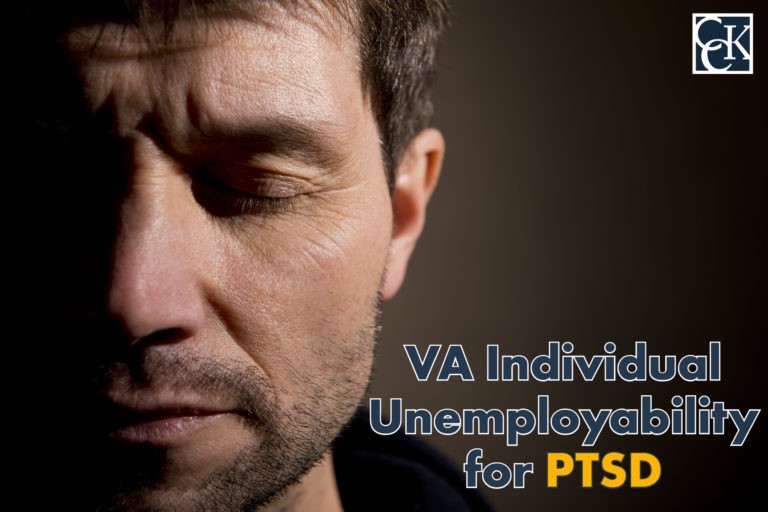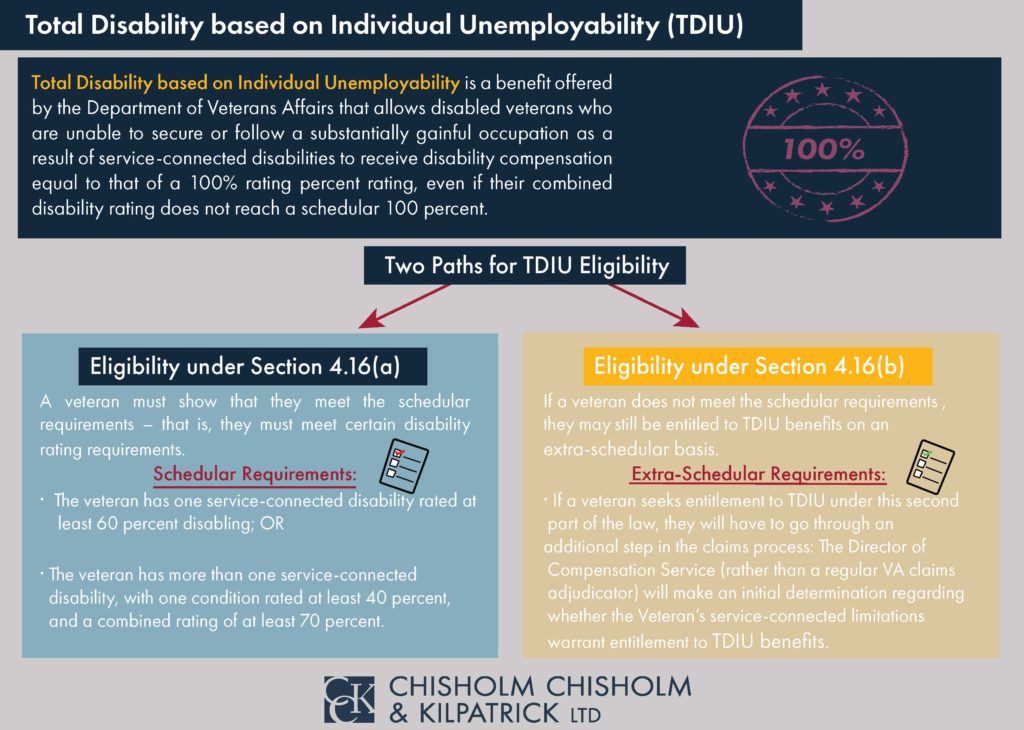Am I Eligible for VA Individual Unemployability Based on My PTSD?

CCK Law: Our Vital Role in Veterans Law
What is Post-Traumatic Stress Disorder (PTSD)?
Post-traumatic stress disorder (PTSD) is a mental health condition that occurs as a result of experiencing a distressing, shocking, or otherwise traumatic event. Many veterans develop PTSD from events they witnessed or experienced during their military service. Many veterans’ PTSD symptoms can qualify for individual unemployability.
Statistics have indicated that PTSD is one of the most common conditions that affect the veteran community. It is commonly associated with other mental health conditions, such as anxiety and depression. Additionally, PTSD does not only occur immediately after trauma; in some cases it can take years to manifest. Symptoms of PSD can also range in severity from person to person.
Symptoms of PTSD
- Re-experiencing the trauma through intrusive, distressing recollections of the event, flashbacks, and nightmares
- Emotional numbness and avoidance of places, people, and activities that are reminders of the trauma
- Increased arousal such as difficulty sleeping and concentrating, feeling jumpy, and being easily irritated and angered
VA Service Connection for PTSD
To obtain direct service connection for PTSD, the veteran will need to demonstrate three things to VA:
- A current diagnosis of PTSD—Without a current diagnosis, veterans are not eligible for VA disability benefits. Usually, a therapist, psychiatrist, or general practitioner can make a formal diagnosis using the Diagnostic and Statistical Manual of Mental Disorders, 5th Edition (DSM-5).
- A statement from the veteran about the stressor that occurred during service—Generally speaking, the occurrence of the stressor should be consistent with the circumstances of the veteran’s service. In some cases, veterans will have to provide VA with evidence to corroborate the reported stressor. Corroborating evidence involves evidence from a source other than the veteran supporting the claim that the in-service stressor occurred. Such evidence can include buddy statements, military records, newspaper articles, police reports, and more.
- A medical opinion that the stressor was sufficient enough to cause PTSD from a VA psychologist/psychiatrist, or a psychologist/psychiatrist under contract with VA—Lastly, the veteran will need to establish a medical nexus (i.e., link)between their PTSD and the in-service stressor. A medical nexus is not required such in cases where PTSD is presumed to be connected to your service (i.e., combat exposure, fear of hostile military or terrorist activity, prisoner of war, or military sexual trauma). However, when a medical nexus is necessary, it must demonstrate that the PTSD is at least as likely as not related to an in-service stressor.

How Does VA Rate PTSD?
If a veteran is granted service connection for PTSD, VA will then assign a disability rating which correlates to the amount of monthly compensation the veteran will receive. When assigning a rating, VA will consider the frequency, duration, and severity of symptoms, as well as the level of social and occupational impairment the veteran faces.
Usually, the more severe the veteran’s symptoms are, the higher the disability rating. VA rates PTSD under 38 CFR § 4.130, Diagnostic Code 9411, General Rating Formula for Mental Disorders. The rating scale ranges from 0 to 100 percent.
Each rating has specific criteria that a veteran will typically need to meet in order to receive that rating. However, a veteran does not need to endorse all of the symptoms listed for each rating. A Court of Appeals for Veterans Claims case, Mauerhan v. Principi, established that the symptoms listed in Diagnostic Code 9411 (i.e., post-traumatic stress disorder) are not intended to constitute an exhaustive list, but rather serve as examples of the type and degree of the symptoms, or their effects, that would justify a particular rating. Below are the criteria for each rating:
- 100%–This rating is for veterans who experience “total occupational and social impairment.” Symptoms may include gross impairment in thought processes or communication, persistent delusions or hallucinations, grossly inappropriate behavior, persistent danger of hurting self or others, intermittent inability to perform activities of daily living (such as minimal maintenance of personal hygiene), disorientation to time or place, memory loss for names of close relatives, occupation, or name.
- 70%–Veterans rated at 70 percent experience occupational and social impairment, with deficiencies in “most” areas. Symptoms may be similar to those listed above in the 100 percent criteria. Impairment may affect the veteran’s work, school, family relations, thinking or mood. Veterans rated at this level may also experience suicidal ideation.
- 50%–The 50 percent rating is given to veterans with occupational and social impairment, specifically with “reduced reliability and productivity.” Symptoms can include panic attacks more than one a week, difficulty understanding complex commands, impairment of memory, impaired judgement, disturbances of mood, and difficulty establishing and maintaining effective work and social relationships.
- 30%–To secure the 30 percent rating, veterans will experience occupational and social impairment with “occasional decrease in work efficiency” and periods of inability to perform occupational tasks. Symptoms may include depressed mood, anxiety, suspiciousness, panic attacks, chronic sleep impairment, and mild memory loss.
- 10% –10 percent ratings are given to veterans with occupational and social impairment from “mild or transient symptoms” that can decrease work efficiency or the ability to perform occupational tasks during periods of stress.
- 0%–The 0 percent rating is non-compensable, meaning that it is not associated with any financial compensation. With the 0 percent rating, veterans have a diagnosis, but the symptoms may not be severe enough to interfere with occupational or social functioning.
- However, this rating is still important because it establishes service connection for the condition and can help the veteran receive an increased rating later on, as well as grant them eligibility to certain other VA benefits. Importantly, if your PTSD significantly impairs your ability to work, you may be eligible for a total disability rating based on individual unemployability.
What is VA Individual Unemployability (TDIU)?
Total disability based on individual unemployability (TDIU) is a VA benefit that allows veterans to receive benefits at the 100 percent rate if their service-connected condition(s) prevent them from securing and maintaining substantially gainful employment.
Veterans who are service-connected for PTSD may be eligible for Individual Unemployability if their condition prevents them from working.
What Are the Requirements for VA Individual Unemployability (TDIU)?
There are two ways veterans can qualify for Individual Unemployability under VA’s regulation 38 CFR § 4.16: schedular and extraschedular. In order to be eligible for schedular individual unemployability for PTSD:
- You must have one condition (e.g., PTSD) rated at 60 percent or higher on its own; or
- You must have a combined rating of 70 percent or higher when your PTSD is taken together with other service-connected conditions and at least one of those conditions is rated at 40 percent or higher.
If you do not meet the eligibility requirements listed above, but you are unemployable due to your PTSD, you may qualify for Individual Unemployability on an extraschedular basis. In both cases, you must show that your PTSD (along with your other service-connected conditions, if applicable) contributes to your inability to work.
Proving Your PTSD Impacts Your Ability to Work for Individual Unemployability
To be eligible for VA individual unemployability based on your PTSD, you must demonstrate that your PTSD prevents you from securing and maintaining substantially gainful employment. There are multiple ways to do this:
Obtaining Private Medical Opinions
While Compensation and Pension (C&P) examinations intend to help VA determine the severity of your symptomatology, it may be helpful to obtain a private medical opinion, or an expert opinion, to substantiate your claim.
Vocational Evidence
Vocational experts compare the requirements of a veteran’s particular employment to the limitations caused by their PTSD.
- For example, vocational experts might consider factors such as reliability, concentration, and productivity to form an opinion about whether a veteran can function in a competitive work environment
Vocational evidence can be particularly compelling because it can provide a wider scope of the veteran’s limitations that may not otherwise be mentioned in medical examinations.
Social Security Determinations
Veterans can use their receipt of Social Security Disability Insurance (SSDI) and Supplemental Security Income (SSI) as evidence to support their VA claim for individual unemployability benefits.
In fact, VA is required to consider social security determinations as evidence. The Social Security Administration and VA both share the goal of determining whether a person is unable to work, although VA is only concerned with service-connected disabilities. As such, both organizations may use these determinations.
Additional Evidence Veterans Can Submit
Veterans can also submit additional evidence as well. This may include lay statements from a veteran or someone who has witnessed the limitations the veteran faces every day, such as a spouse, family member, or co-worker.
In this case, lay statements should address the extent of the veteran’s PTSD and the impact it has on daily life, specifically in regard to employment. This type of evidence can provide valuable insight about your disability that is not always conveyed through other evidence.
Protected Work Environment and Individual Unemployability: Accommodations for Your PTSD
In some situations, employers may make accommodations that allow veterans to maintain employment. It is important to note that under these circumstances, you may still qualify for TDIU based on your PTSD.
If your employer makes special (and significant) accommodations for you based on your PTSD, without reducing your earnings or benefits, VA should find that you are employed within a protected work environment. Protected work environments cannot be considered substantially gainful employment. As a result, you are still eligible for Individual Unemployability.
An example of this may involve the following: a veteran who is suffering from PTSD struggles with social interaction. As a result, he is allowed to take multiple breaks throughout the day, and does not have to handle as many customers, but his employer does not reduce his pay or penalize him for being less productive than other employees.
100% PTSD Disability Rating vs. Individual Unemployability (TDIU)
Neither the 100 percent schedular rating nor TDIU is better than the other, as they both provide VA disability compensation at the 100 percent rating amount. However, depending on the circumstances, one of these options might be more beneficial to pursue.
The major differences between the two involve the qualifying criteria and the work restrictions:
- 100% PTSD Rating—There are not any work restrictions when receiving a 100 percent PTSD disability rating.
- 100% Rating Through TDIU—Individual Unemployability allows you to receive compensation at the 100 percent level when you are unable to work and your PTSD and other service-connected conditions do not meet the 100 percent rating criteria. Importantly, a veteran cannot receive TDIU if they are employed in a substantially gainful position that is not a protected work environment.
Generally, a schedular 100 percent disability rating for PTSD is often difficult to obtain because it requires a veteran’s symptoms to be so severe that they are totally impaired and unable to function in everyday life.
Call Chisholm Chisholm & Kilpatrick LTD for a Free Case Evaluation
If you are suffering from PTSD as a result of your military service, Chisholm Chisholm & Kilpatrick LTD may be able to help you receive the VA disability benefits that you deserve, including TDIU. To speak with a member of our staff about a free case evaluation, please call our office today 800-544-9144.
About the Author
Share this Post


